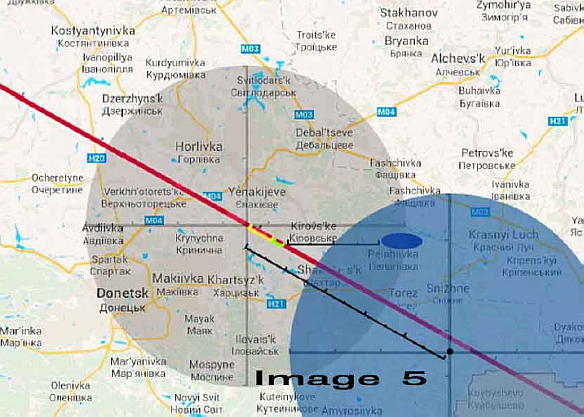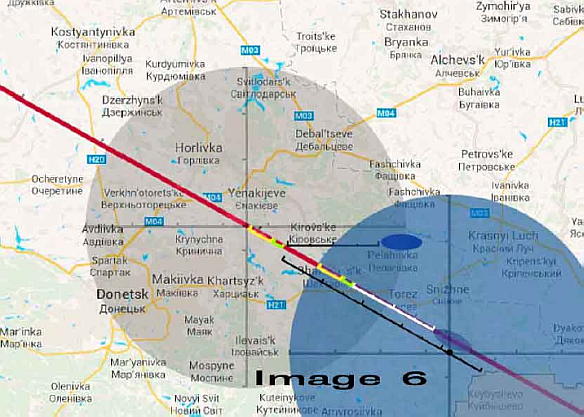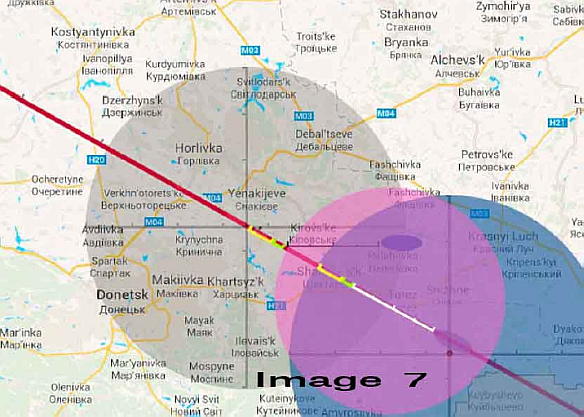SECTION 3
The Telegraph’s Rebel Buk Position
The Telegraph has reported locating a Buk firing position to the southeast of the town of Snizhne. The site was located using photographs provided by the Ukrainian SBU, the security department of the Ukraine Ministry of the Interior. The SBU image was taken in Torez and purports to depict the smoke contrail of a Buk missile fired by the rebel forces.
A blogger attempted to locate the ground position of this smoke contrail using landmarks contained in the photograph. This suggested a firing position to the south of Snizhne. A reporter from the London Telegraph inspected the suspect area and located a patch of scorched earth in a grain field. The adjacent farm track showed evidence of a vehicle, possibly tracked, having passed through this location. This position south of Snizhne accords with web imagery that shows a Buk traveling south on the divided highway leading from Snizhne toward the Russian border.
This firing location was located on Google maps. It is depicted in Image 5. The blue gray circle represents the 35 km missile range of the 9М38M1 missile. The black dot at the center marks the Telegraph’s purported firing position.
What is immediately clear from this imagery is that the point of missile interception lies more than 50 km from the purported firing position located south of Snizhne. It is well outside the 35 km range of a Buk M-1 missile. There is absolutely no possibility that a Buk missile fired from this position could have struck MH17 and resulted in the ground impact outside Hrabove. The radar on the TELAR unit could not have seen MH17. The aircraft was outside both the 42 km radar range and the 35 km missile range.
Image 6 shows the likely placement of the debris field if a Buk TELAR south of Snizhne had engaged MH17 at the earliest possible opportunity. Using the same data as previously employed it is clear that the debris field would fall almost directly over the launch position.
The course of 118 degrees for the track of MH17 can be verified by flight radar tracking but the precise alignment of that track may be called into question. Some representations show MH17 passing directly over Horlivka. This would place MH17 even further out of range from a Buk M-1 firing position south of Snizhne. Image 7 imposes a 50 km circle on the periphery of the Russian border. Even if MH17 had passed directly over Horlivka, the engagement zone required to produce a debris field in the vicinity of Hrabove still lies outside the range of a Buk missile fired from south of Snizhne.
Image 8 shows a representation of a course track of 118 degrees passing directly over Horlivka. The debris field remains in approximately the same position but has been realigned with the course track. The white segment represents the free fall trajectory, the Green segment the distance travelled in the 3 minute interval between the reported explosions and the loss of radar contact and the Yellow segment represents the distance travelled during missile flight time. It is clearly impossible for a Buk M-1 located in the Telegraph’s reported position south of Snizhne to have brought down MH17. This engagement location sits well north of a 50 km distance from the Russian border.
It is noted that the BBC had a team in the Snizhne area and they also searched for a Buk firing position. They found nothing and received no citizen reports of sighting a missile contrail. The Telegraph came along later and did locate a position marked by scorched earth and heavy equipment tracks. Regardless of what the Telegraph claims to have found, it is physically impossible for a missile fired from the Telegraph’s position to have intercepted MH17.
The next section examines the available data to identify the Buk position that fired the missile that intercepted MH17 and caused the loss of 298 lives.







